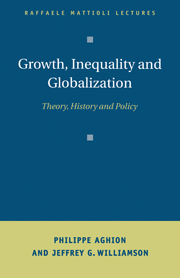Part I - Inequality and economic growth
Published online by Cambridge University Press: 04 November 2009
Summary
Introduction
The question of how inequality is generated and how it reproduces over time has been a major concern for social scientists for more than a century. Yet the relationship between inequality and the process of economic development is far from being well understood. In particular, for the past forty years conventional economic wisdom on inequality and growth has been dominated by two fallacies:
On the effect of inequality on growth in market economies, the standard argument is that inequality is necessarily good for incentives and therefore good for growth, although incentive and growth considerations might (sometimes) be traded off against equity or insurance aims.
This conventional wisdom has been challenged by a number of recent empirical studies. Several papers have used cross-country regressions of GDP growth on income inequality to examine the correlation between these two variables. Alesina and Rodrik (1994), Persson and Tabellini (1994), Perotti (1996), and Hausmann and Gavin (1996b) have all found that there is a negative correlation between average growth and measures of inequality over the 1960–1985 period (although the relationship is stronger for developed than for developing countries). Persson and Tabellini (1994) also present time-series evidence for nine developed economies over the period 1830–1985: their results show that inequality has a negative impact on growth at all the stages of development that these economies have gone through in the past 150 years (see Benabou (1996) for a comprehensive review of the literature).
- Type
- Chapter
- Information
- Growth, Inequality, and GlobalizationTheory, History, and Policy, pp. 5 - 102Publisher: Cambridge University PressPrint publication year: 1999
- 11
- Cited by

